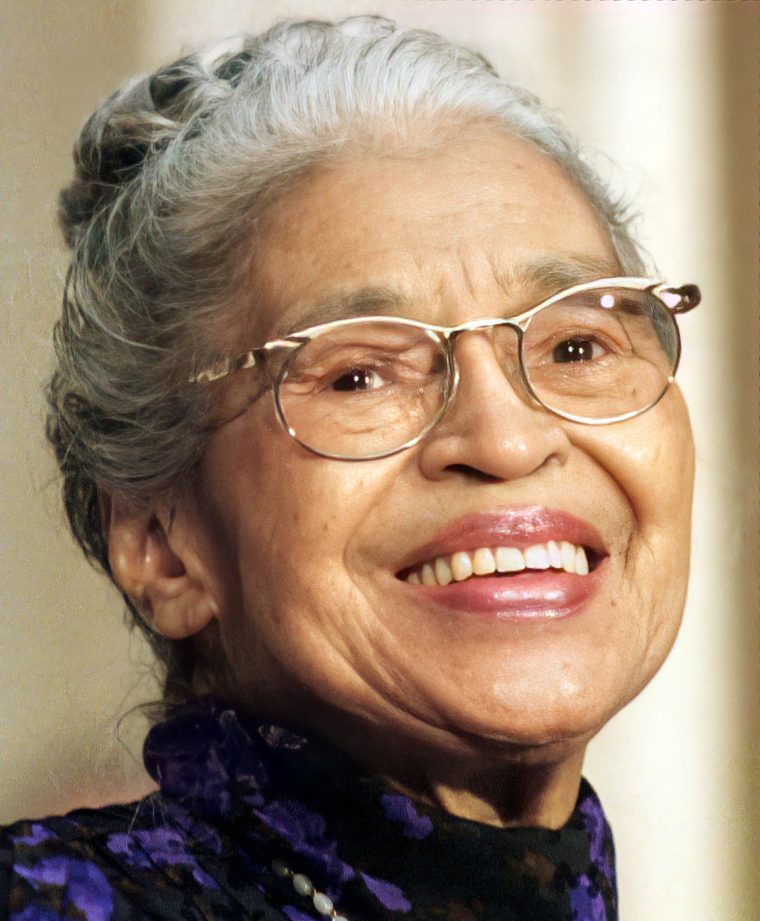ROSA PARKS, The First Lady of Civil Rights Movement in America

Did you know that Rosa Parks refusal to relinquish her seat on a public bus precipitated the 1955–56 Montgomery bus boycott in Alabama, which became the spark that ignited the civil rights movement in the United States?
Rosa Louise McCauley Parks was an American activist in the civil rights movement best known for her pivotal role in the Montgomery bus boycott in the United States and was honoured by the US Congress as "the first lady of civil rights" and "the mother of the freedom movement". She became a National Association for the Advancement of Colored People (NAACP) activist in 1943, participating in several high-profile civil rights campaigns.
In the 1900, a segregation law in the United States' gave special privileges to whites and prevented them from sitting together with blacks in a bus. The city of Montgomery in Alabama had passed a city ordinance to segregate bus passengers by race. Conductors were empowered to assign seats to achieve that goal. According to the law, no passenger would be required to move or give up their seat and stand if the bus was crowded and no other seats were available. Over time and by custom, however, Montgomery bus drivers adopted the practice of requiring Black riders to move when there were no White-only seats left.
The first four rows of seats on each Montgomery bus were reserved for Whites. Buses had "colored" sections for Black people generally in the rear of the bus, although Blacks composed more than 75% of the ridership. The sections were not fixed but were determined by placement of a movable sign. Black people could sit in the middle rows until the White section filled. If more Whites needed seats, Blacks were to move to seats in the rear, stand, or, if there was no room, leave the bus. Black people could not sit across the aisle in the same row as White people. The driver could move the "colored" section sign, or remove it altogether. If White people were already sitting in the front, Black people had to board at the front to pay the fare, then disembark and reenter through the rear door. For years, the Black community had complained that the situation was unfair.
One day in 1943, Parks boarded a bus and paid the fare. She then moved to a seat, but driver James F. Blake told her to follow city rules and enter the bus again from the back door. When Parks exited the vehicle, Blake drove off without her. Parks waited for the next bus, determined never to ride with Blake again.
After working all day, Parks boarded the Cleveland Avenue bus, a General Motors Old Look bus belonging to the Montgomery City Lines, around 6 pm, Thursday, December 1, 1955, in downtown Montgomery. She paid her fare and sat in an empty seat in the first row of back seats reserved for Blacks in the "colored" section. Near the middle of the bus, her row was directly behind the ten seats reserved for White passengers. Initially, she did not notice that the bus driver was the same man, James F. Blake, who had left her in the rain in 1943. As the bus traveled along its regular route, all of the White-only seats in the bus filled up. The bus reached the third stop in front of the Empire Theater, and several White passengers boarded. Blake noted that two or three White passengers were standing, as the front of the bus had filled to capacity. The bus driver moved the "colored" section sign behind Parks and demanded that four Black people give up their seats in the middle section so that the White passengers could sit.
When Parks refused to give up her seat, a police officer arrested her. Parks was charged with a violation of Chapter 6, Section 11, segregation law of the Montgomery City code, although technically she had not taken a White-only seat; she had been in a colored section. Edgar Nixon, president of the Montgomery chapter of the NAACP and leader of the Pullman Porters Union, and her friend Clifford Durr bailed Parks out of jail that evening.
Parks did not originate the idea of protesting segregation with a bus sit-in. Those preceding her included Bayard Rustin in 1942, Irene Morgan in 1946, Lillie Mae Bradford in 1951, Sarah Louise Keys in 1952, and the members of the ultimately successful Browder v. Gayle 1956 lawsuit (Claudette Colvin, Aurelia Browder, Susie McDonald, and Mary Louise Smith) who were arrested in Montgomery for not giving up their bus seats months before Parks. Nixon conferred with Jo Ann Robinson, an Alabama State College professor and member of the Women's Political Council (WPC), about the Parks case. Robinson believed it important to seize the opportunity and stayed up all night mimeographing over 35,000 handbills announcing a bus boycott. The Women's Political Council was the first group to officially endorse the boycott.
On Sunday, December 4, 1955, plans for the Montgomery bus boycott were announced at Black churches in the area, and a front-page article in the Montgomery Advertiser helped spread the word. At a church rally that night, those attending agreed unanimously to continue the boycott until they were treated with the level of courtesy they expected, until Black drivers were hired, and until seating in the middle of the bus was handled on a first-come basis.
The next day, Parks was tried on charges of disorderly conduct and violating a local ordinance. The trial lasted 30 minutes. After being found guilty and fined $10, plus $4 in court costs (combined total equivalent to $153 in 2022), Parks appealed her conviction and formally challenged the legality of racial segregation. The case became bogged down in the state courts, but the federal Montgomery bus lawsuit Browder v. Gayle resulted in a November 1956 decision that bus segregation is unconstitutional under the Equal Protection Clause of the 14th Amendment to the U.S. Constitution.
Parks, who played an important part in raising international awareness of the plight of African Americans and the civil rights struggle, died of natural causes on October 24, 2005, at the age of 92, in her apartment on the east side of Detroit. She and her husband never had children and she outlived her only sibling. She was survived by her sister-in-law (Raymond's sister), 13 nieces and nephews and their families, and several cousins, most of them residents of Michigan or Alabama.
#penglobalpersonality #RosaParks



